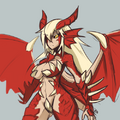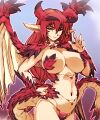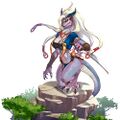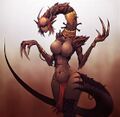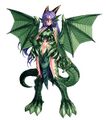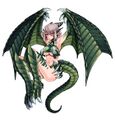Dragon: Difference between revisions
1d4chan>Saarlacfunkel |
|||
| Line 14: | Line 14: | ||
===Medieval Times=== | ===Medieval Times=== | ||
In Medieval lore, the most important dragon story is that of | In Medieval lore, the most important dragon story is that of [https://en.wikipedia.org/wiki/Saint_George_and_the_Dragon Saint George and the Dragon]. Most depictions of dragons descend in some way from it (either directly, or by imitating something that imitated it). Also of note: Beowulf's third book is about him fighting a dragon to his death. | ||
===Asia=== | ===Asia=== | ||
Revision as of 14:45, 17 December 2019
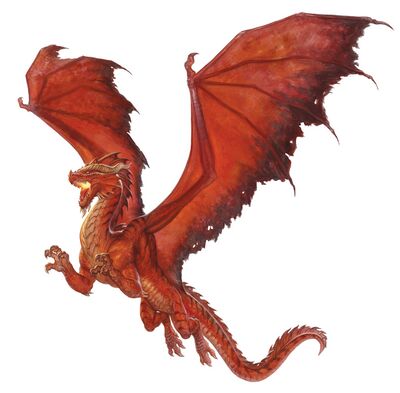
"I kill where I wish and none dare resist. I laid low the warriors of old and their like is not in the world today. Then I was but young and tender. Now I am old and strong, strong, strong [...] My armor is like tenfold shields, my teeth are swords, my claws spears, the shock of my tail a thunderbolt, my wings a hurricane, and my breath death!"
- – Smaug, The Hobbit
Dragons are mythical creatures found all around the world (although this is admittedly more due to decisions on the part of early translators than anything else "hey Jack, what should we designate as the translation of "Qetzacouatl" the feathery serpent thing from mesoamerica?" "I don't know... 'dragon'?"), possibly inspired by various sources such as giant lizards such as varanids, crocodillians and serpents, but also dinosaur bones and simple tall-tales from travelers in distant lands. Dragons are often portrayed as keepers of vast hordes of treasure, which they accumulate over their very long lifespan and guard covetously - in western mythology, this is often an extension of their use as a metaphor for royal power. They can often fly and breathe fire or poison. Because of their majestic, fantastic nature dragons are a staple of much fantasy fiction and games. One of the most well known dragons is Smaug, from Tolkien's The Hobbit. The vast majority of later portrayals of dragons in fiction were based on Smaug, who in turn had been inspired by the dragon Fáfnir, from the Völsunga Saga and the dragon from Beowulf. In modern days dragons, being pretty much the the logo of fantasy as a genre, have a wide variety of natures and depictions. Some are as smart as (if not smarter than) humans, some are no smarter than an iguana. Some are inherently magical, some not. Some are good, some are evil, some neutral. Basically, go nuts.
A surprisingly common feature of dragons in fantasy is the "dragon rider," a warrior who, somehow, is usually harnessed up to a dragon, which actually has two justifications besides "Awesome": For an intelligent dragon, they offer a slight, but non-trivial edge in combat (spotting threats early, and possibly giving you a new attack if they have a weapon that's effective versus other dragons, at a slight to moderate cost in extreme flight maneuvers); for unintelligent dragons, being able to field them at all in war.
Mythology
Classical
There are a bunch of monsters that might be referred to as a "dragon" by modern readers; among them are Apep of Egypt, various beasts from Mesopotamian myths, the Greek Hydra, and the Jewish Leviathan. The fact that so many different cultures across such vast gulfs of time and space all come up with the same general idea of what a dragon is, has generally be attributed to dinosaur fossils which appear all over the earth.
Medieval Times
In Medieval lore, the most important dragon story is that of Saint George and the Dragon. Most depictions of dragons descend in some way from it (either directly, or by imitating something that imitated it). Also of note: Beowulf's third book is about him fighting a dragon to his death.
Asia
Asian Dragons are typically long, snake-like creatures, and are generally less malevolent than their European counterparts. They tend to be associated with water rather than fire. At least one Chinese creator-goddess appeared as a hybrid of woman and dragon, whilst there are Japanese stories of noble men marrying female dragons. They don't usually have wings, flight being accomplished either by magic or riding the wind.
Elsewhere
Dungeons & Dragons
Dragons are one of the main selling points of the Dungeons & Dragons game, to the point that the 4th edition and 5th edition include a draconian race called Dragonborn, intended for players who "want to look like a dragon".
Dragon kind and Half-Dragons are basically the confirmation of the rule that dragons can mate with anything, taking their place among the races often referred to as "slut races": humans, fiends, celestials, dryads, slaadi, modrons, inevitables, formians and gribbly abominations from the Far Realm. We now permit you to take a break to use the brain oxi-clean provided to you by Billy Mays' ghost to scrub any mental images you may have of a human, dragon, angel, balor, black slaad, formian queen or-OH SWEET MERCIFUL GOD-EMPEROR THE MENTAL IMAGE!!!!
"True" dragons, meanwhile, come in all shapes and sizes, from the evil Chromatic to the good Metallic, the psionic Gem dragons, elemental dragons, plane-aligned dragons (one for each Outer Plane except Arcadia, where dragons are hated), Astral dragons, disaster dragons and even the potent and rare Time Dragons, who are amongst the most dangerous creatures in existence.
There are also 'Dragon Riders'. That's to be taken literally in the overwhelming majority of cases, just in case you didn't use enough brain bleach just 5 nanoseconds ago. They're really just pussy knights that stay safe just pointing the dragon in the right direction and let it fight for them, occasionally dismounting to deliver a finishing blow or give a pompous bullshit speech. (Except for Viking Dragon Riders, hardcore shit right there!) Though it's important to remember that these are rare in D&D, as everyone in this world, dragons themselves especially, will point out that a human having a pet dragon is like a fly having a pet human. This said, if you read what required said brain bleach above, the other kind of ride does happen occasionally as well. Half-Dragons wouldn't exist otherwise.
Kinds of Dragons
There's a boatload of dragons in D&D, many of whom fit into the following groups:
- Chromatic Dragons - The original dragons, coming in a variety of colors. They are all some variety of evil and are the children of the dragon goddess Tiamat. In order of power White, Black, Green, Blue and Red are the five most common colors, but others include yellow, brown, purple and a whole rainbow of other colors.
- Metallic Dragons - Starting out with only the gold dragon, in later editions they became linked to Bahamut, the god of good dragons. The most common ones are Brass, Copper, Bronze, Silver and Gold in order of power, with others including Iron, Steel and Adamantine.
- Ferrous Dragons - A subgroup of the Metallic Dragons, Ferrous Dragons are made of base metals instead of the noble ones.
- Gem Dragons - Adorned with crystal scales, the Gem Dragons have potent psionics and are usually also the go-to Neutral dragons to the Metallics' Good and Chromatics' Evil.
- Catastrophic Dragons - Introduced in 4e, these dragons have been infused with elemental power by the Primordials to make them look like elemental dragons.
- Planar Dragons - Dragons linked to the various Planes of existence, frequently the Outer Planes of Planescape. All of said Outer Planes have their own kind of dragon, except for Arcadia where dragons are despised.
- Oriental Dragons - Based on Asian dragons, the Oriental Dragons are the dragons used in such settings. They generally have close ties to nature, like forests, the skies, the seas... or carp! Notable is that the Gold Dragon, the first Metallic Dragon, was stylized as such a dragon, but was changed to a more traditional western design (although they did retain their bitchin' moustache of barbels). Also known as Lung Dragons. Pathfinder calls them Imperial Dragons.
- Dragonets - Miniature dragons more suitable for familiars or high fantasy worlds, featured in Advanced Dungeons & Dragons.
- Linnorms - Nordic-themed dragons who possess wing-less serpentine bodies with only a set of forelimbs. Usually described as being even nastier and crueler than Chromatics.
- Song Dragons - Originally called "Weredragons", an all-female race of dragons who use their ability to assume human form to interact with mortal races and find mortal spouses.
- Epic Dragons - Introduced in the Epic Level Handbook. Epic dragons are much larger and more powerful than regular dragons. They are usually neutral aligned but have more variation in alignment than other kinds of dragons. The first two kinds of Epic Dragons, Force Dragons and Prismatic Dragons, were introduced in the Epic Level Handbook.. Force Dragons are immune to force effects and have a very powerful force breath and force based spell-like abilities, and also become more difficult to see as they age until they are completely invisible as Great Wyrms. Prismatic Dragons are immune to prismatic and light based spells and blindness and have a breath weapon based on the prismatic spray spell, and can use several other prismatic and light based spell-like abilities. A third type called Time Dragons were indroduced in Dragon Magazine.
- Wyverns - Dim-witted, feral, more bestial dragons who lack a breath weapon, have wings instead of forelimbs, and a poisonous stinger.
- Undead Dragons - Various kinds of undead dragon have appeared throughout editions, from the famous Dracolich to less-famous zombie, skeletal and vampire dragons.
- Shadow Dragons - Depending on edition, either a dragon with some elemental affinity to darkness, a planar dragon, or an undead dragon.
There's also a great medley of setting-unique dragons, such as those native to Mystara and Dragonlance.
Finally, there are the Dragon Gods, a loose pantheon of deities unique to D&D dragons that hasn't traditionally gotten a lot of attention because, well, they only really give a fuck about dragons and dragons don't usually get too religious (they don't like acknowledging something as being bigger than them). The advent of the Dragonborn as a PC race is likely to change this, however.
| The Dragons of Dungeons & Dragons | |
|---|---|
| Dragons | Albino Wyrm - Arcane Dragon - Aquatic Dragon - Brine Dragon - Catastrophic Dragon - Cerilian Dragon - Chromatic Dragon - Cloud Dragon - Cobra Dragon - Crimson Dragon - Deep Dragon - Dragonet - Epic Dragon - Faerie Dragon - Fang Dragon - Ferrous Dragon - Gem Dragon - Half-Dragon - Linnorm - Metallic Dragon - Minidragon - Mist Dragon - Moon Dragon - Obsidian Dragon - Oriental Dragon - Planar Dragon - Prismatic Dragon - Pseudodragon - Radiant Dragon - Red Hawk Dragon - Sand Dragon - Sea Wyrm - Shadow Dragon - Song Dragon - Stellar Dragon - Stone Dragon - Sun Dragon - Dragon Turtle |
Shadowrun
Dragons from Shadowrun come in four types depending on where they originate from: Western Dragons (European and North American), Eastern Dragons (Asian}, Feathered Serpents (South American and African), and Sea Dragons (any of the oceans}. Despite morphological differences between the different breeds, they all can interbreed, and all share the mentality of highly intelligent, manipulative, avaricious douchebags. In their natural forms, dragons cannot speak verbally but instead use telepathy, which cannot be recorded; most dragons of significance in the setting have metahuman "Voices" who relay their words for them in telecommunication or recorded interviews.
In D&D-descended settings, being a corrupt, amoral, greedy entity that forces less-privileged beings to worship them would make them glorified, if terrifying, bandits at best. In the gritty cyberpunk society of Shadowrun, Dragons can do all of this within the margins of a legitimized and prosperous career, intermingling with metahuman society on the boards of megacorps and in seats of power in the few polities that matter. Although they like to use these newfound levers of power that the mortals built up, they also conform to a draconic culture that exists beside (or more accurately, outside) metahuman society. Draconic society also has a loose hierarchy; the Great Dragons reside at the top, sometimes duking it out and sometimes working with one another as they pursue individual agendas, and the "lesser" dragons doing their own thing are left alone, as long as they don't step on the Greaters' toes and occasionally take orders.
What separates the Greater Dragons from the rest isn't entirely understood. While there's a strong correlation with power and age separating the Greats from the rest, considering the ways they think, what makes a Great isn't quite so crude.
Also due to the gritty cyberpunk setting, dragons aren't entirely good or evil, but exist more along a morally ambiguous spectrum. Unlike D&D, where the dragons are separated into the various flavor of evil chromatics and good metallics, Shadowrun dragons are all individuals with their own motivations and ambitions and personal hopes and fears, even though they are all ancient, alien beings who can't help but see metahumanity as mostly small and ephemeral beings, where some of them can even be considered good. They remain the biggest power players in the Shadowrun setting, driving much of the conflict and intrigue as they fight amongst each other and other powers, but also stand united in protecting the world and metahumanity from the terrors of the Horrors.
Some of the most notable dragons are:
- Aden: The only known Great Sirrursh (a variant of the Eastern Dragons). He likes to appear to humanity as either a beautiful man or a handsome woman, mostly to fuck with people. He's best known for destroying Tehran after a fatwah was declared against metahumans and the Awakened, so standing up for the people who weren't normie humans means he'd probably be an okay guy if he weren't so edgy and angry all the fucking time. Currently pulling strings against the various Muslim movements in the Middle East and balancing fending off Lofwyr's attempts to muscle in on his territory.
- Alamais: A Great Western Dragon, Lofwyr's brother and chief rival, and would-be champion of the downtrodden if here weren't a huge fucking prick. Liked to associate with populist movements, like underground political scenes and terrorist organizations to get his work done, and was probably responsible for some of Lofwyr's woes. Also advocated for hunting metahumans for sport. Also also had an ongoing prank war with Dunkelzahn where they traded a fruitcake for 37 years, mostly through shadowrunners breaching one another's defenses. Died in 2074 in a war that tore apart a section of Italy and left 38 other adult dragons dead.
- Arleesh: A Great Feathered Serpent, known to travel the world to hunt down and destroy magical artifacts that pose a danger to metahumanity. Probably pretty cool if she could let her hair down once in a while.
- Celedyr: A Welsh Great Western Dragon. Less concerned about power and wealth than he is with knowledge, and hence technology, and thus became CTO of NeoNET. He then worked for just enough shares to pursue the avenues of research he wanted to and be left alone, or was outmaneuvered by Machiavellian human CEO Richard Villiers in powerplays over NeoNET, depending on who you listen to. Was the mentor and patron of lesser dragon Eliohan, a Matrix guinea pig, which also kicked off the CFD plotline (which nobody cared about). Also sponsor of the Knights of Rage streetgang, who serves as his agents out in the world.
- Dunkelzahn: Widely and justifiably considered to have been the most gregarious and open-minded of the dragons, particularly when it came to giving metahumanity a fair shake. The Big D was the Dude. Less of an oligarch and more of an eccentric, Big D didn't put all of his chips into one nation/megacorp like the other dragons did, so he became a broad entrepeneur and collector. He started a public career with a late night talk show and ended up successfully running for President of the UCAS, until a car bomb killed him some ten hours after his swearing in. The who and why is still unclear, though the "consensus" for those in the know is that he committed suicide, making himself into a sacrifice that would rebalance the astral from the Great Ghost Dance from some decades before. The Big D wasn't immune to draconic dickishness though; his will turned much of the established power structures on their heads and continues to influence the plot some 20 years down the line. Lofwyr, going full Tsundere mode, pointed out to some folks that "he wasn't such a great guy" and that he was still a dragon first and foremost, and his will was still enacting plots that furthered his personal goals many years after his death.
- Eliohan: A lesser Western dragon who was abducted and experimented on by an Ares subsidiary by installing a datajack, making him the only known dragon with a meaningful relationship with the Matrix. Despite being "driven insane" and technically impossible, he loved the feeling and became a good decker as well as president of the subsidiary that abducted him. It was sold off to NeoNET a few years later where he reconnected to his mentor Celedyr. Eliohan flatlined in Crash 2.0, but his conscious survived as an E-Ghost, prompting Celedyr to research ways into downloading a conscience into a braindead meat body to restore his apprentice. Despite quite a bit of being fucked about from behind the scenes, including the entirety of the CFD plot, Eliohan was returned to his body, letting him continue to live a normal dragon life.
- Feuerschwinge: A German Great Western Dragon. When she woke up, she went on a bloody rampage that left many thousands of people dead until she was shot down by the German military. It was probably because she had a strong ecological bent, and humanity fucking with the environment drove her crazy. Probably. Probably.
- Ghostwalker: A Great Western Dragon and Big D's brother. His first act upon awakening was taking control of Denver (or technically, the FRFZ) and banning Aztlan for reasons hardcore Shadowrun fans would understand. He has a thing for spirits' rights, to the point where he is violently against binding or even summoning spirits within his territory.
- Hestaby: A Great Western Dragon from the Pacific Northwest. She first appeared to end the war between California and Tir Tairngire, basically telling the kids to get off her lawn and go home. She cultivated a public persona of an egalitarian guardian of nature and metahumanity, level-headed and moderate in comparison to her brethren. The Great Dragons felt that she was taking metahumanity's side against her own kind and convened a trial that declared her outcast.
- Lofwyr: A Great Western Dragon from Germany, Lofwyr is the richest person on Earth. You know how counterculture people want to stick it to The Man? Yeah, that's Lofwyr. He is The Man. Most of his fortune is a result of his leveraged buyout and subsequent expansion of the Saeder-Krupp industrial corporation; he lives in its headquarters in the Rhine-Ruhr Megaplex arcology. He is probably also the power behind the throne of the Gasperi Mafia family, which controls the criminal underworld in Rhine-Ruhr. His name is known and feared worldwide, and he was the direct inspiration for the Sixth World aphorism "never deal with a dragon".
Warhammer
Dragons have appeared since the beginning in Warhammer Fantasy, but they're ironically one of the most vaguely defined parts of the lore. They will ally themselves with the High Elves and be used as powerful (and in game terms: expensive) mounts for elven lords. Aside from being intelligent, there's not much stated about them. Some dragons have also been corrupted by Chaos and fight alongside the Warriors of Chaos. In both cases, they are made out to be among the most powerful monsters in the setting, and their stats live up to it, with only few models, including Greater Daemons, having a chance at beating them.
Storm of Magic sees the return of "Emperor dragons", huge dragons that are arguably the most powerful units in the book. Emperor dragons not allied with Chaos can also be upgraded all the way up to level four sorcerers, in addition to having nearly all 9s across their statline. This does make them extremely expensive, ruling out their use in all but the highest-point games.
Dragons also have a connection with the vampires, the reason being their blood has the power to cure their otherwise ceaseless thirst for blood. Abhorash and Zacharias The Everliving being the primary beneficiaries of this, where they defeated the beast either with straight up glorious approach or just cowardly draining their blood in their sleep. Abhorash then formed the Blood Dragons and tells his disciples if they want some of that sweet dragon ambrosia they have to go out and earn it themselves.
Speaking of dragon slaying, it is a popular hobby in the world of Warhammer, where the reason said slayers participate in such activity is to either prove themselves, die gloriously or having the glory to kill it, the aforementioned thirst for blood as well as making it serve as a pretty sweet mount in undeath, for food or just killing them for fun.
Some prefer to just tame them by rearing them from an egg then riding them into battle when they are big enough. Races or Factions like the Empire (Karl Franz's dragon and Elspeth von Draken's Carmine Dragon are the only example for the human, for now), the High Elves, Wood Elves, Vampire Counts(undead dragon, so is more of a summoning than taming), Warriors of Chaos, and the Dark Elves examples of this.
Like in many settings, Warhammer has a number of different types, beyond the common/Emperor Dragon split.
- Sun Dragon - The youngest and smallest breed of High Elven dragons.
- Moon Dragon - Older and rarer than Sun dragons.
- Star Dragon - The largest, most powerful, rare and eldest of all dragons.
- Moon Dragon - Older and rarer than Sun dragons.
- Black Dragon - Dragons corrupted by Dark Elven magic. Sulekh being Malekith's second dragon (first black dragon) to replace his old one. After Sulekh's death, it was replaced by Seraphon as Malekith's third dragon (second black dragon), who Malekith instantly favored because of its ruthless action of destroy the eggs around him upon its birth.
- Sea Dragon - Corrupted dragons which have grown so large they can no longer fly. The Dark Elves now use them to tow their massive ships.
- Forest Dragon - Dragons that have adapted to live in the deep forests, so long that their will now linked to the Athel Loren itself, and fight whenever the forest will. In total war warhammer, It is a forest green beast with antler growing on its head, butterfly pattern on it's wing and leaves, vines growing on its body as a proof of its connection with the forest.
- Shard Dragon - Serpentine dragons that adapted to the deep places of the world. They would attack everything they met no matter how harmless they are. Dwarf miners often encountered and awoke these assholes slumber and were met with not only predictable result, also a shit tons of grudge if there were survivors. Some Runesmiths put a rune collar on them and send them to battle like how the lizard man done to the dread saurian. But knowing the Dwarfs, a few long beards would got off their chair and start bitching at the dishonorable and repugnant idea of bringing monster onto the battlefield and why not just put the trustworthy Dawi axe onto the face of the enemy.
- Chaos Dragon - Dragons perverted by the ruinous powers, typically Tzeentch. No two are said to be alike, but they tend to have two heads. Galrauch is said to be the first chaos dragon. Possessed by a lord of change, it wreck peoples shit while earning hundreds of Dwarven grudges on The Dammaz Kron. Egrimm van Horstmann also has a chaos dragon called Baudros.
- Carmine Dragon - Dragons that are born tied to the amethyst winds of death magic. Elspeth von Draken being the only known to have it as a mount so far.
- Toad Dragon - Giant lumbering reptilian horrors with insatiable appetites and a frog-like tounge. Oftern serves Nurgle worshipers. Tamurkhan owned a Toad Dragon named Bubebolos and it is the most well known and the greatest of its kind.
- Zombie Dragon - Basically dead dragon raised by Vampires to become their mount.
- The Imperial Dragon - The Empire's only owned dragon (Elspeth's dragon does not count). It was taken from the deepest cave of the black mountain. Only Karl can rode it in battle. It sits in the imperial zoo of Altdorf whenever Karl rodes deathclaw to battle. It is also nameless. The poor dragon just can't be anymore popular than deathclaw huh?
- The Dragon Emperor - Not to be confused with the above entry. Cathay's ruler is a dragon capable of taking human form. Not much is known about him, given Cathay's lack of fluff in general. But what we do know about them is that they share the same serpent like appearance like real life Asian dragon and they are awesome at being a magic caster (especially lore heaven), so awesome that they fucked up the ogre tribes living north, created the great maw and sunk a Dark Elf Black Ark. Its is also known that the Dragon Emperor is able to intercourse with human which result in many citizen in Cathay that shares their blood. Shugengan are Cathayian magic users who had Dragon blood in their vein and are talented at magic because of it.
Warcraft
Dragons are one of the oldest creatures in Azeroth granted great magical abilities by the Titans that shaped their world. In a reversal of their typical role, dragons in Warcraft were all originally benevolent, although their way of thinking and doing things didn't always line up with the short-term thinking of some of the mortal races. They were originally a species of proto-dragons that had wyvern-like wings which they used as forelimbs, two puny fore arms and two muscular rear legs and a tail. As a gift for their assistance in defeating the most powerful proto-dragon, Galakrond (Imagine a warhammer Ghorgon but as a dragon whose breath is so bad it literally wakes the dead), during the ordering of Azeroth the Titans altered them to be the larger and more intelligent four-legged dragons. They are segregated into five types called dragonflights each with different roles and abilities bestowed to them by one of the five Titans. Each dragonflight was assigned by a Titan to protect some aspect of their work on Azeroth while they went off to do Titan stuff else where in the universe. The leader of a dragonflight is called an Aspect, and some dragonflights still have their original Aspects.
- Red dragonflight: Led by Alexstrasza the Life-Binder, red dragons are fierce guardians of life. They were also given a degree of dominion over the other dragonflights.
- Blue dragonflight: Originally led by Malygos, and later by Kalecgos. Their domain is the aspect of magic. The blue dragonflight is said to be the least populous flight.
- Green dragonflight: Aspects of nature who have a strong bond to a realm called the Emerald Dream. Said to be the most populous dragonflight, though most rarely venture out of the Dream. Led by Ysera the Dreamer.
- Nightmare dragons: Green dragons and their allies which have been twisted by a corruption in the Emerald Dream called the Emerald Nightmare, they now embody the negative aspects of nature such as decay and rot, and serve the Old Gods.
- Bronze dragonflight: Tasked with watching over time and making sure nobody messes with the timeline, bronze dragons are patient and reclusive. Led by Nozdormu the Timeless.
- Infinite dragonflight: Bronze dragons who go rogue, they intentionally attempt to sabotage history to prevent past calamities. Led by future Nozdormu when he finally goes batshit insane due to seeing all the cataclysms well in advance and not being able to prevent them. His current-time self is perfectly aware that will eventually happen to him (it was part of the deal making him the guardian of time to reveal his eventual end to him) but there's nothing he can do about that either!
- Black dragonflight: Originally aspects of earth, tasked with keeping watch of the deep places. Which backfired horribly, because that's where the Old Gods hang out! Originally led by Neltharion the Earth-Warder, later known as Deathwing, he fell to evil and the rest of his flight followed suit. Now they are all treacherous assholes and nobody likes them they and take every possible opportunity to kill them, thus they have been hunted nearly to extinction. There are two non-evil black dragons whose minds were freed from the malicious influence of the Old Gods before they were hatched thanks to titan artifacts: Ebyssian, also known as Ebonhorn, a Spirit-Walker of the Highmountain Tribe, and Wrathion, the supposed heir of Deathwing who has taken it upon himself to make sure Azeroth doesn't get fucked.
- Chromatic Dragonflight: A dragonflight created by Nefarian, one of the most prominent black dragons, through gruesome experiments, combining the features and abilities of all five flights. Almost every one of these creations were unstable, deformed, infertile and/or short-lived, with a single exception: Chromatus, a five-headed dragon who could only be stopped by the combined efforts of the aspects (excluding Deathwing).
- Twilight Dragonflight: Originally created by Sintharia/Sinestra, the twilight dragonflight suffered from similar problems to Nefarian's chromatic dragons. That is, until Deathwing came along and combined the efforts of both to perfect the twilight dragons, successfully creating a powerful breed of dragons that feed vampirically on all forms for energy. The twilight dragonflight was nearly driven to extinction following the Cataclysm.
Things turn bad for the dragonflights when the black dragon aspect Neltharion was corrupted by the Old Gods who were imprisoned by the Titans deep within Azeroth. He plotted to destroy Azeroth to release his new masters when the Burning Legion, an army of demonic invaders led by the fallen Titan Sargeras, began to attack Azeroth. With their world under siege, Neltharion tricked the other four dragons into lending their powers to the Dragon Soul, a powerful artifact of his design, only to betray them and use it against them slaying many dragons. This treachery caused the other dragons to go into hiding away from each other, and although Neltharion (who had now assumed the name Deathwing) was eventually defeated, the world was twice shattered by cataclysms and the Dragon Soul would resurface periodically throughout history to pain the dragonflights until its eventual destruction, which drained the flights of much of their powers and turned them mortal.
Additionally, there exist other dragons that didn't ascend alongside the five main flights, but still share a similar physique and level of intelligence. An example of such is the Storm Dragons of Stormheim, and the supposed existence of a violet dragonflight of proto-drakes.
Warmachine
The creatures called "dragons" in the Iron Kingdoms look nothing like dragons in other worlds. Rather than winged serpentine creatures of majesty and power, the "dragons" of Caen are monstrosities of inconsistent form and not of this world, capable of altering the bodies and minds of other creatures in horrific ways with an exotic energy they constantly emit, an energy the people of this world simply call "blight." The only thing known about their origin is that the gods did not create them. They are immortal as long as their athanc (a kind of heartstone) is not destroyed. A dragon reproduces by chipping off a piece of its athanc and letting it generate a new body, but such offspring have an innate urge to recombine their athancs and control all the power within them. There are two dragons of significance in Caen: Dragon Lord Toruk, god and master of the Cryx faction and "father" to the other known dragons, and Everblight, a shard of Toruk that went off and did its own thing with elves and mutations, eventually creating its eponymous faction.
Monstergirls

| This article contains PROMOTIONS! Don't say we didn't warn you. |
 | This article or section is about Monstergirls (or a monster that is frequently depicted as a Monstergirl), something that /tg/ widely considers to be the purest form of awesome. Expect PROMOTIONS! and /d/elight in equal measure, often with drawfaggotry or writefaggotry to match. |
Dragons are large, dangerous, majestic and exotic creatures, so of course people want to fuck them. Dragons, in their normal form or a more human form are of the scaly subgroup of Furries: furries attracted to things with scales instead of fur. They have a minor reputation of being That Guy amongst the furries because they have to be so special and fuck mythological creatures instead of dogs, cats, horses, foxes, rabbits and birds like "normal" people.
While dragons in a humanoid shape (i.e. Dragonborn) are enjoyed by quite a few people, a large number prefer dragons in their natural shapes. For them it's about the contrast between the large and powerful dragon and their small and fragile frame: the fear makes their boners strong. There's also the perverts who want their dragons to have nonhuman genitals, which is a concept that the infamous Bad Dragon company has capitalized on by selling their infamous dragon dildos, which are often used as the punchline of a joke.
One of the things that dragons in D&D are infamous for is their ability to breed with just about any creature, and not being shy about it. (Just take a look at for instance the Song Dragons.) Only Constructs and Undead can't reproduce with them, and even then it's possible to build or raise a dragon from the dead. This means that you can encounter anything from draconic unicorns and owlbears to draconic plants, slimes, aberrations and far worse (or better, depending on your perspective)).
Portraying "non-morphic" (ie: no breasts) female dragons on /tg/ in a semi-erotic light is a real act that stirs contention. On the one hand, this is a well-known part of the furry fandom. On the other hand, dragons are iconic fantasy creatures. Plus, in Dungeons & Dragons, it's canon that many dragons like to get them some non-draconic loving, with their two patron/creator gods Tiamat and Bahamut first in line to nab themselves some quality mortal ass on a regular fashion and setting the example for their progeny. And that's when said progeny hasn't evolved to breed with humanoids in the first place, see aforementioned Song Dragons. So people will fight bitterly whenever they pop up in a thread, you can guarantee.
Naturally, the idea of dragons as sexy quickly was taken up by the monstergirls crowd - in fact, one of the earliest Ecchi OVAs to make it into America was "Dragon Half", in which the main character was the Half-Dragon daughter of a female dragon and a male human, her father being sent to slay the dragon and forgetting the "s" while underway. Pink appeared as a cute girl with dinky little dragon wings, cute horns, a tail and the ability to breathe fire. In fact, Pink has actually come to be the defining archetype for the dragongirl in MG fandoms; a human girl with horns, wings, a tail and, optionally, scales on the limbs - sometimes with paw-like feet, digitigrade legs, or even paw-like hands. It helps that this tends to be pretty accurate to D&D's own depiction of half-dragon humanoids (up to the social maladjustment of having such weird parents, played for laughs in the manga). As with any "beastgirl", dragon-girls with full-body scales or weirdly-colored skin are contentious because, no matter how human their face, they may look too furry for some purists to accept.
Dragon-girls are very popular in Japanese fantasy media, especially videogames. Final Fantasy even has a race, the Gria, who are an entire species of cute dragon-girls native to Ivalice.
Strangely, despite the existence of more "player friendly" dragon races like Dragonborn, Dray and Spellscales - the latter of whom are even supposed to have evolved from Half-Dragon sorcerers - the idea of reskinning these races to present them as dragon-girls never really gets mentioned. This likely has something to do with the fact that these races are less powerful than the half-dragon, and the standard "I want to be a dragon-girl!" player/DM also wants to have all of the draconic powers - Breath Weapon, Damage Reduction, and Flight.
Gallery
-
At least one of these forms will please some anon out there.
-
Asian dragons are beasts - or beast-girls - of a different color.
-
A classic example of the monstergirl dragon.
-
The "scale bikini" look is popular for dragon-girls.
-
Well, when a dragon kidnaps a princess, sometimes the kingdom gets an heir out of it.
-
There's something for everyone.
-
Some like their dragons with breasts.
-
Some like their dragons au naturale.
-
Even the dread Athasian Dragon isn't immune to the monstergirls treatment.
-
A rare example of the Faerie Dragon getting the MG treatment.
-
Exhibit A in why furries & /tg/ have such a love-hate relationship.
Monster Girl Encyclopedia
Naturally, the Monster Girl Encyclopedia has its share of dragon-themed monstergirls.
The actual "Dragon" fits the same kind of style first seen on the setting's Lizardgirl; scaly limbs, paw-like hands and feet, a tail, fin-like ears, horns and wings. They are characterized by their extreme pride; whilst not quite tsunderes, they're determined to give themselves only to the best possible man.
In a terrible irony, if a Dragon fails to find a husband before she dies, the dark energies permeating the world will reanimate her as a Dragon Zombie, a corpse-colored (blue-gray skin, dark mold-green wings, white hair) dragon with bony scales. In this state, her mind has degenerated, leaving her a horny bimbo obsessed with finding a man and taking him for her mate. These dragon-girls are quite dangerous, because they possess a "rotten breath" attack that can convert human women into undead monstergirls.
The Wyvern is a dragon-girl with a more harpy-like body structure, having wings instead of arms. These are far more friendly and easy-going than the standard dragons and readily team up with human adventurers to train them as "dragoons".
The Wurm is a linnorm-style dragon-girl, essentially a massively strong lamia with paw-like hands, with an extremely lustful, aggressive personality that sees them going out and chasing after a man.
The Jabberwock is a lewd, lascivious, depraved dragon-girl from the "Wonderland" region. It can be distinguished by its dark red colors and the presence of two tentacles, each of which bears a slavering maw and lecherous tongue used to pleasure victims and guzzle semen.
Finally, there are the two dragons of Zipangu. The Ryu is another lamia-like dragon, a gentle-natured and benevolent mamono with powers to control the weather. The Otohime is an aquatic dragon-girl who resembles a mermaid with the body of a seahorse (long story; seahorses are believed by the Japanese to be connected to dragons) and clawed hands, who seduces men to join her in her life of eternal partying in her palace under the sea. Have no fear from her seahorse appearance, though; pedophilia and rape aside, the MGE is far too vanilla to allow even pegging into its setting, never mind male pregnancy.
-
The original Dragon mamono, proud and haughty and determined to take only the best.
-
Back from the grave, and now a shameless bimbo.
-
She's the Queen Slut, and she's proud of it.
-
Loyal, steadfast and true, even if she's not the curviest of monstergirls.
-
Don't let her looks fool you; she will punch through mountains to chase you down.
-
Beloved and mystical dragon-girl of Zipangu.
-
Party-girl from below the waves.
Life with Monstergirls
Meanwhile, Life with Monstergirls has the Dragonewts. They have wings and tails like dragons, as well as some scales on their faces and clawed hands. In the series we meet a Dragonewt named Draco, who tries to steal Miia away from her darling. While initially appearing to be male she's later revealed to be a flat-chested woman who develops an obsession with Miia, and it takes a couple of bullets to her wings from Manako and a reprimanding from Suu to cool her off. Other variants of the Dragonewt is the Chinese Ryu-jin who has horns and has no wings, and the aggressive but dim-witted Wyvern.
Gallery
See Also
- Johnniass Dragonraper is known to rape a dragon on occasion.
- Toothless Dragon the Dawww-est dragon.
- The Periodic Table of Dragons.


